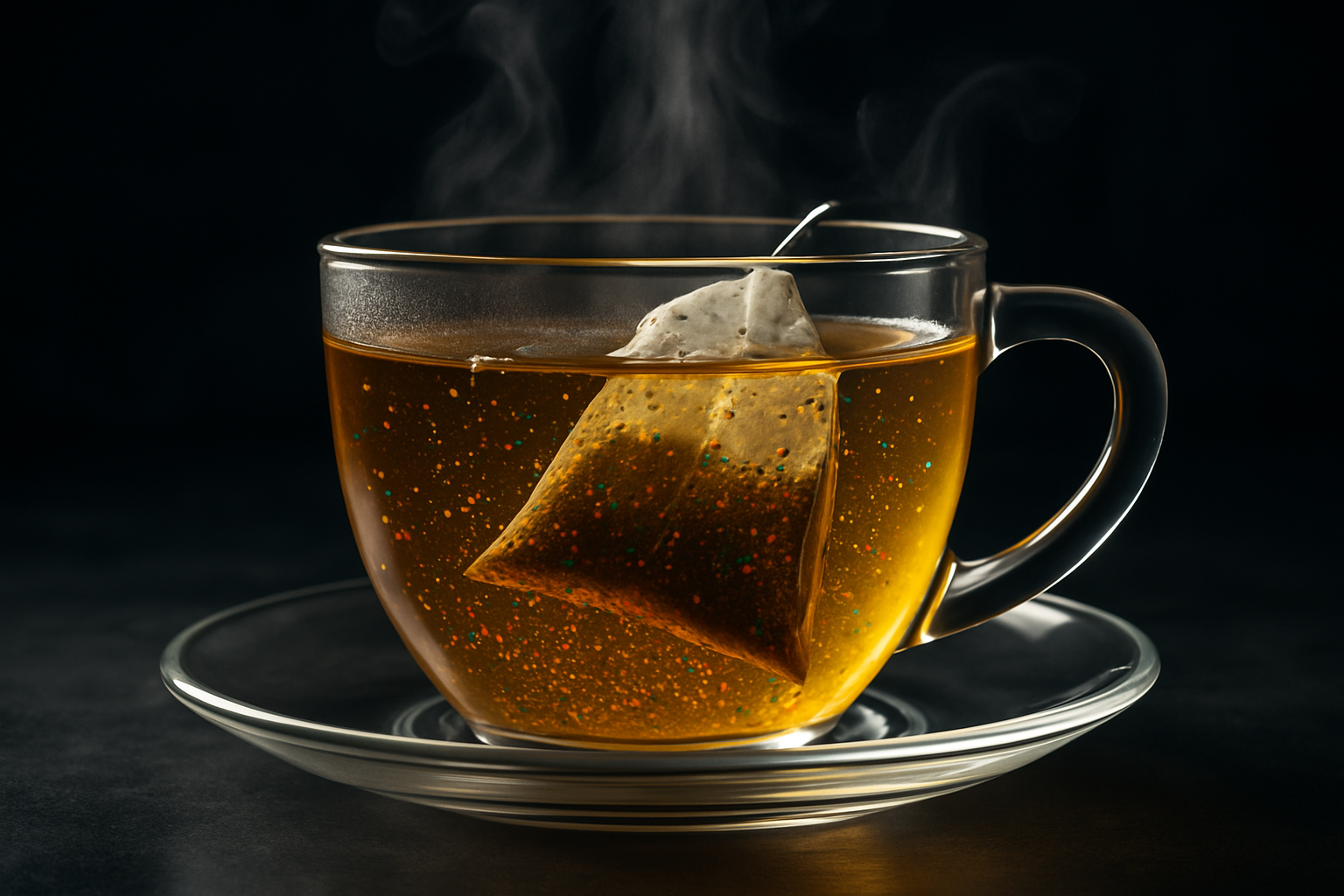
Tea Bag Terror: 11.6 Billion Microplastic Particles Per Cup
A shocking study has revealed that plastic tea bags release an astounding 11.6 billion microplastic particles per cup - over 1,000 times more than any other food source. This discovery has transformed the simple act of brewing tea into one of the highest sources of microplastic exposure in the modern diet.
The Tea Bag Contamination Crisis
What was once considered a healthy, natural beverage has become a major source of plastic contamination. The shift from traditional paper tea bags to plastic alternatives has created an unprecedented exposure pathway for microplastics.
Staggering Contamination Levels
- 11.6 billion particles released per tea bag
- 1,000x higher than any other food source
- Polypropylene tea bags showing highest contamination
- Nylon tea bags releasing 7.2 billion particles per cup
- Heat activation dramatically increases particle release
Why Tea Bags Are Contamination Hotspots
Several factors make tea bags particularly problematic for microplastic contamination:
- High temperature exposure: Boiling water accelerates plastic degradation
- Extended steeping time: Longer contact increases particle release
- Thin plastic construction: Tea bag materials are designed to be permeable
- Agitation during brewing: Movement breaks down plastic structure
- Acidic environment: Tea compounds accelerate plastic breakdown
Tea Bag Material Analysis
Not all tea bags are created equal. Different materials show dramatically different levels of microplastic contamination, with some releasing thousands of times more particles than others.
Highest Risk Tea Bag Materials
Polypropylene Tea Bags
Polypropylene tea bags represent the worst contamination source, releasing the full 11.6 billion particles per cup. These clear, plastic tea bags are increasingly common in premium tea brands.
Nylon Tea Bags
Nylon tea bags, often used for pyramid-shaped bags, release approximately 7.2 billion particles per cup. While slightly lower than polypropylene, they still represent an enormous contamination source.
PET Tea Bags
PET (polyethylene terephthalate) tea bags show moderate contamination levels but still release millions of particles per cup, particularly when exposed to high temperatures.
Safer Tea Bag Alternatives
Paper Tea Bags
Traditional paper tea bags show minimal microplastic contamination, though some may contain plastic sealants. Look for unbleached, plastic-free paper bags.
Loose Leaf Tea
Loose leaf tea represents the safest option, eliminating tea bag contamination entirely. Use metal or ceramic strainers to avoid any plastic contact.
Brand Analysis: Tea Contamination Levels
Our analysis of popular tea brands reveals significant variations in microplastic contamination levels, with some brands posing much higher risks than others.
High-Contamination Tea Brands
Premium Plastic Tea Bags
Many premium tea brands have switched to plastic tea bags for their "luxury" appearance, inadvertently creating the highest contamination levels. These include pyramid-shaped bags and clear plastic sachets.
Moderate-Risk Tea Options
Traditional Tea Bag Brands
Traditional tea brands using paper tea bags with plastic sealants show moderate contamination levels. Products like Lipton Black Tea and Tetley Black Tea fall into this category.
Lower-Risk Tea Choices
Organic and Plastic-Free Brands
Organic tea brands often use plastic-free packaging and paper tea bags without synthetic sealants. These represent the safest bagged tea options available.
Health Implications of Tea Bag Contamination
The massive microplastic exposure from tea bags creates unique health risks, particularly for regular tea drinkers who may consume multiple cups daily.
Daily Exposure Calculations
Cumulative Contamination
- 1 cup daily: 4.2 trillion particles annually
- 3 cups daily: 12.7 trillion particles annually
- 5 cups daily: 21.2 trillion particles annually
- Heavy tea drinkers: Among highest microplastic exposure globally
Specific Health Risks
The enormous particle load from tea bags creates several health concerns:
- Gastrointestinal irritation: Billions of particles overwhelming digestive system
- Systemic inflammation: Immune system response to foreign particles
- Cellular damage: Oxidative stress from plastic particle accumulation
- Endocrine disruption: Chemical additives leaching from plastic particles
Vulnerable Populations
Certain groups face higher risks from tea bag microplastic contamination:
- Pregnant women: Potential impacts on fetal development
- Children: Higher exposure relative to body weight
- Elderly individuals: Reduced ability to process and eliminate particles
- Individuals with digestive disorders: Increased sensitivity to particle irritation
Safe Tea Consumption Guidelines
Tea lovers don't need to give up their favorite beverage entirely. By making informed choices about tea types and preparation methods, contamination can be dramatically reduced.
Immediate Protection Strategies
✅ Safer Tea Choices
- Loose leaf tea with metal strainers
- Paper tea bags without plastic sealants
- Organic tea brands with plastic-free packaging
- Traditional tea preparation methods
- Glass or ceramic brewing vessels
⚠️ Tea Bags to Avoid
- Pyramid-shaped plastic tea bags
- Clear plastic tea sachets
- Nylon mesh tea bags
- Polypropylene tea bags
- Any transparent tea bag material
Brewing Method Modifications
Even when using safer tea bags, brewing methods can impact contamination levels:
- Lower water temperature: Use 80-85°C instead of boiling water
- Shorter steeping time: Reduce contact time to 2-3 minutes
- Gentle handling: Avoid squeezing or pressing tea bags
- Single use only: Never reuse tea bags
Alternative Beverage Options
For those concerned about tea bag contamination, several alternatives provide similar benefits:
- Herbal infusions: Fresh herbs steeped directly in water
- Matcha powder: Whisked green tea powder without bags
- Traditional tea ceremonies: Loose leaf preparation methods
- Cold brew tea: Lower temperature extraction methods
The Future of Tea Safety
The tea bag contamination crisis has prompted calls for industry reform and regulatory action to protect consumers from unnecessary microplastic exposure.
Industry Response
Some tea companies are beginning to respond to contamination concerns:
- Plastic-free initiatives: Return to paper and biodegradable materials
- Transparency efforts: Clearer labeling of tea bag materials
- Alternative packaging: Compostable and plastic-free options
- Consumer education: Information about contamination risks
Regulatory Needs
The tea bag crisis highlights the need for stronger regulations:
- Material disclosure requirements: Mandatory labeling of tea bag composition
- Contamination limits: Maximum allowable microplastic levels
- Testing standards: Standardized methods for measuring contamination
- Public health warnings: Consumer alerts about high-risk products